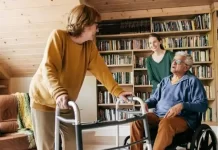As the population gets older, keeping seniors safe and healthy becomes more important. One clever solution that’s becoming popular is wearable panic buttons. These handy devices act like a lifeline for seniors, giving quick access to help during emergencies.
Whether living alone or in senior communities, these panic buttons boost safety and bring peace of mind to both seniors and their families. This article looks at the benefits of these devices, what features they offer, different types available on the market today, plus some tips for picking out the best option.
Benefits of Wearable Panic Buttons
Wearable panic buttons bring many advantages, especially for seniors who might face accidents or health issues. One major benefit is the quick access to emergency help. With a simple button press, medical professionals or family members can be alerted right away. This speed can make all the difference during falls, heart attacks, and other emergencies where time matters.
Many of these devices also include GPS tracking features. This helps caregivers find seniors quickly if they wander off or get lost—a crucial tool for those with dementia or Alzheimer’s disease. Plus, having wearable panic buttons boosts feelings of safety among seniors. It reduces anxiety and encourages an active lifestyle overall.
Key Features of Wearable Panic Buttons
Modern panic buttons for wearables come packed with features that boost their effectiveness. Many of these devices allow two-way communication, so seniors can talk directly to a responder who assesses the situation and gives instructions. Some models are waterproof, making them safe to use in the shower or bath—places where accidents often happen.
Long battery life is another important aspect, ensuring readiness whenever needed. Certain wearable panic buttons even connect with smartphones for added benefits like health monitoring and medication reminders.
Plus, some have fall detection technology that automatically sends an alert if a fall occurs—even if pressing the button isn’t possible at that moment. All these advanced features make wearable panic buttons reliable safety tools for seniors.
Types of Wearable Panic Buttons
There are many kinds of wearable panic buttons to choose from, each designed for different needs and preferences. Neck pendants are a favorite because they’re easy to use and can be seen easily. They hang around the neck, making them quick to grab in an emergency.
Wristbands offer another option. They look like watches and provide a more subtle choice. Clip-on devices attach right onto clothing, allowing flexibility in how they’re worn. Some seniors might lean toward advanced models that connect with smartphones or smart home systems for extra features.
Each type has its own benefits, so picking one really depends on lifestyle and comfort level. Important factors include ease of use, durability, and specific requirements when choosing a wearable panic button.
Choosing the Right Wearable Panic Button
Choosing the right wearable panic button takes some thought. First, it’s important to look at what seniors need and how they spend their day. For someone who is active and loves being outdoors, a device with GPS tracking that can handle wear and tear might be best.
Next up is ease of use. The device should be simple enough for seniors to operate without stress, especially in tough situations. It’s also good to check out all the features available; not every feature will matter for everyone’s safety. While extras like fall detection or two-way communication are nice perks, they aren’t always necessary.
Lastly, consider costs involved—some devices come with monthly fees for monitoring services which need factoring into any decision made. By keeping these points in mind, families can find a wearable panic button that offers solid protection and peace of mind for loved ones.
Conclusion
To sum it up, wearable panic buttons are a great way to keep seniors safe and secure. They offer quick access to help when needed and come with useful features in different styles. These devices are crucial for seniors living on their own or in assisted communities. By selecting the right option, families can boost safety and improve life quality for older loved ones.























